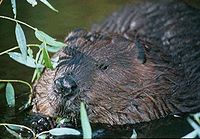
Photo from wikipedia
Abstract Burrow-dwelling rodents are often considered ecosystem engineer species in arid environments. They create distinct habitat patches by building burrows: they move large amounts of soil, mix soil layers and… Click to show full abstract
Abstract Burrow-dwelling rodents are often considered ecosystem engineer species in arid environments. They create distinct habitat patches by building burrows: they move large amounts of soil, mix soil layers and change soil properties locally. Our aim was to explore the role of Steppe Marmot as an ecosystem engineer in shaping the plant species composition and diversity of steppes. First, we made a literature search to gather information on the ecosystem engineering effect of the species. Second, in a case study, we compared the vegetation of marmot burrows with the surrounding intact steppes in North-Kazakhstan to identify differences in species composition and plant functional groups. Vegetation of the burrows was structurally and compositionally different from the intact steppe vegetation. Burrows were characterised by lower total vegetation cover, higher cover of annuals and lower cover of perennial grasses compared to the intact steppe. We found an increased cover of ruderal species on the burrows, but also several specialist species, such as Agropyron cristatum, Anabasis salsa, Kochia prostrata and Petrosimonia spp. were confined to the burrow vegetation. Our results suggest that marmot burrows increase the landscape-scale heterogeneity of the steppe vegetation and could act as stepping stones for the dispersal of several steppe-specialist species.
Journal Title: Journal of Arid Environments
Year Published: 2020
Link to full text (if available)
Share on Social Media: Sign Up to like & get
recommendations!